Gaming Laptops : Performance You Can Trust, Brands You Know
Gaming laptops have come a long way in recent years. What used to be bulky machines with loud fans and limited battery life are now sleek, powerful systems capable of running demanding games and handling creative workloads. Whether you're buying your first gaming laptop or upgrading from an older system, choosing the right one can still feel complicated — especially with so many specs, models, and price ranges to compare.
This page is here to help break things down in a practical way. We’re not trying to tell you which laptop is the “best,” but instead walk you through what actually matters — like which GPU fits your needs, what kind of screen is worth paying for, and when it makes sense to spend more (or save some).
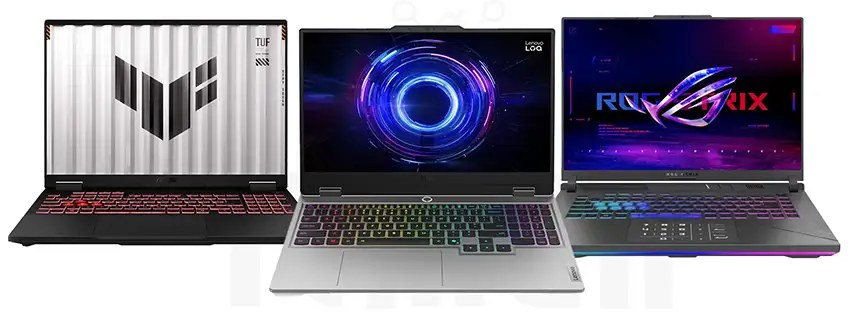
What Makes a Laptop “ Gaming ”?
A gaming laptop is defined by its ability to run modern video games smoothly. That usually means it has a dedicated graphics card (GPU), a capable processor (CPU), enough RAM, and good internal cooling. Some models also offer fast displays (like 144Hz or 165Hz), mechanical keyboards, or advanced thermal designs — but at its core, a gaming laptop should deliver consistent performance in games.
There’s no one-size-fits-all here. A student who plays casual games in their free time has different needs than someone streaming competitive matches or editing gameplay videos. The trick is knowing how to match hardware to your use case.
1. Graphics Card (GPU): The Most Important Component
If you're shopping for a gaming laptop, the GPU is where you should start. It handles the graphics rendering and has the biggest impact on frame rate and visual quality.
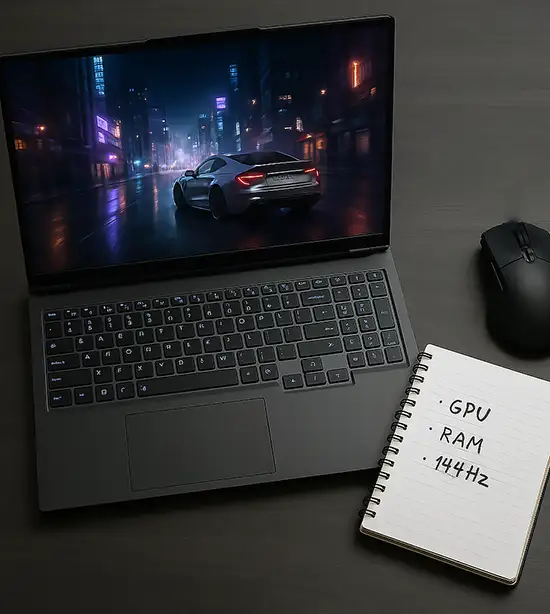
Here’s a rough breakdown:
- NVIDIA RTX 4050 / 4060 / 4070: Best for modern AAA titles at 1080p or 1440p. Supports ray tracing and DLSS. A good balance of power and efficiency.
- RTX 3050 / 3060: Solid midrange choices for esports titles and slightly older games.
- GTX 1650: Entry-level card that’s still decent for light gaming, but aging fast.
- Integrated graphics (Intel Iris / AMD Vega): Only suitable for very light games (e.g. Minecraft, indie games).
f you're into fast-paced competitive games like Valorant or Warzone, aim for an RTX 4050 or higher. It will ensure smooth 144+ FPS at high settings.
2. CPU: Don’t Overlook the Processor
While GPU is king in gaming, the CPU still matters — especially in CPU-bound titles like strategy games, MMOs, or when multitasking (e.g. recording + gaming).
- Intel Core i5 / i7 (12th or 13th Gen): Fast and reliable. Look for H or HX series (e.g. i7-13650HX) for gaming.
- AMD Ryzen 5 / Ryzen 7 (6000/7000 series): Great for multitasking and content creation. Slightly better battery efficiency.
Tip: If you’re just gaming, a modern Core i5 or Ryzen 5 is usually enough. Don’t overpay for high-end CPUs unless you stream, edit, or use heavy software too.
3. RAM and Storage: The Minimums Are Rising
RAM: 16GB is the new baseline for smooth gaming and multitasking. 8GB may still work for casual titles, but most games now recommend 16GB or more.
Storage: Go for at least 512GB SSD — ideally NVMe. Many modern games (like Call of Duty or Cyberpunk 2077) require 70–100GB on their own.
If you plan to install multiple large games or do video editing, consider a 1TB SSD or external storage.
4. Display: Frame Rate and Clarity Matter
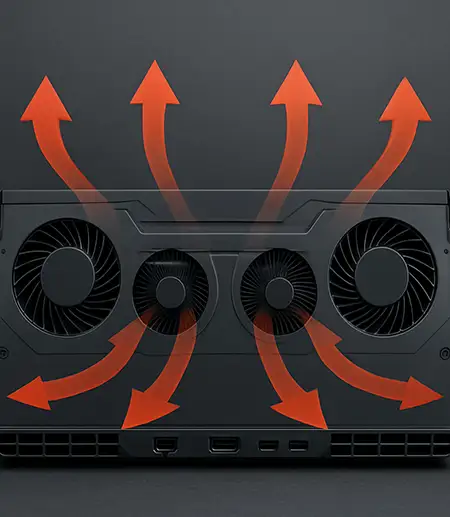
- Refresh Rate: 144Hz is standard in midrange gaming laptops. Higher refresh rates (165Hz, 240Hz) are useful in competitive FPS titles.
- Resolution: 1080p is still the sweet spot for most gamers. 1440p is nice to have, but you’ll need a strong GPU (like RTX 4060+) to support it.
- Panel Type: IPS panels offer better color and viewing angles than TN panels. They’re common in modern gaming laptops.
Don’t get distracted by 4K screens unless you’re doing high-end content work. For gaming, high refresh beats high resolution every time.
5. Cooling: An Underrated Dealbreaker
Gaming generates heat — a lot of it. Poor thermal design leads to throttling, lower performance, and long-term damage. Look for machines with:
- Dual-fan or triple-fan setups
- Large vents and heat pipes
- Review-tested performance under load
Some brands like Lenovo Legion or ASUS ROG put real effort into thermal design. It’s worth checking reviews if you’re investing in a high-performance model.
6. Battery Life: Don’t Expect Miracles
Gaming laptops aren’t built for all-day unplugged use. Even efficient systems rarely get more than 4–6 hours in real-world use, and far less during gaming. That’s normal. Just make sure the power brick isn’t too heavy if you’ll be moving around a lot.
Choosing Gaming laptops Based on Your Use Case
For Casual Gamers / Students
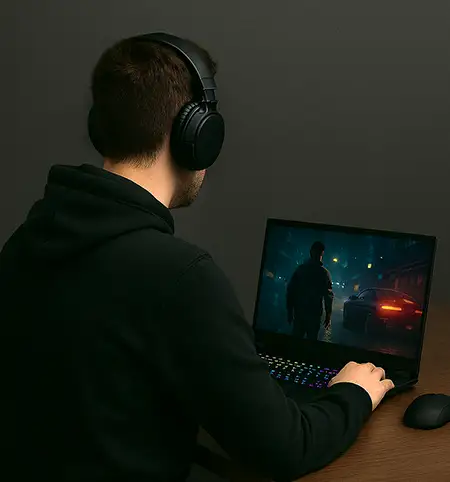
- Budget: Under 4000 AED
- Recommended GPU: GTX 1650, RTX 3050
- Use: Esports titles, casual gaming, study + game mix
- Examples: HP Victus, ASUS TUF (GTX models)
For Mainstream Gamers
- Budget: 4000–6000 AED
- Recommended GPU: RTX 4050 or RTX 4060
- Use: Competitive games, modern AAA titles
- Examples: Lenovo LOQ, MSI Cyborg, ASUS TUF A15
For Hardcore / Creative Users
- Budget: 6000+ AED
- Recommended GPU: RTX 4070+
- Use: 1440p gaming, streaming, video editing
- Examples: Lenovo Legion 5 Pro, ASUS Zephyrus, HP OMEN 17
What About Upgradability?
Most gaming laptops allow upgrades to RAM and storage (SSD), but the GPU and CPU are usually soldered. If you care about future-proofing, get as much GPU as you can afford now. Also, choose laptops with at least one free RAM slot or M.2 bay if possible.
GPU Comparison Table – Gaming Laptop Performance
| GPU Model | Performance (1080p, High) | VRAM | DLSS / Ray Tracing | Power Efficiency | Best For |
|---|---|---|---|---|---|
| GTX 1650 | 45–60 FPS | 4GB | ❌ No | ✅ Good | Esports, light gaming |
| RTX 3050 | 60–75 FPS | 4GB | ✅ Basic RT/DLSS | ✅ Good | Budget AAA gaming, students |
| RTX 3060 | 80–95 FPS | 6GB | ✅ Yes | ⚠️ Moderate | Mainstream 1080p gaming |
| RTX 4050 | 90–110 FPS | 6GB | ✅ DLSS 3 + RT | ✅ Very Good | Modern AAA games, 144Hz displays |
| RTX 4060 | 110–130 FPS | 8GB | ✅ DLSS 3 + RT | ✅ Good | High FPS 1080p / Light 1440p |
| RTX 4070 | 130–150 FPS | 8GB | ✅ DLSS 3 + RT | ⚠️ Higher TDP | QHD gaming, video editing, streaming |
Notes:
- FPS ranges are approximate, based on average performance in modern AAA titles like Cyberpunk 2077, Warzone, and Far Cry 6 at 1080p High settings.
- DLSS (Deep Learning Super Sampling) and Ray Tracing are NVIDIA technologies that enhance image quality and performance in supported games.
- Power efficiency affects thermals, battery life, and cooling requirements.
Real-World Gaming Benchmarks for Popular Gaming Laptops
To help you make sense of raw specifications, here’s a set of simplified, real-world gaming benchmarks based on commonly used gaming laptops with different GPUs. These results show average frame rates at 1080p resolution with high settings — the most common setup for most users in the UAE.
| Game Title | GTX 1650 (Entry) | RTX 3050 | RTX 4050 | RTX 4060 | RTX 4070 |
|---|---|---|---|---|---|
| Valorant | 120+ FPS | 160 FPS | 220 FPS | 240 FPS | 260+ FPS |
| Call of Duty: Warzone | 50 FPS | 70 FPS | 95 FPS | 110 FPS | 130 FPS |
| GTA V | 60 FPS | 85 FPS | 115 FPS | 130 FPS | 140+ FPS |
| Cyberpunk 2077 | – (unplayable) | 45 FPS | 65 FPS | 80 FPS | 95 FPS |
| FIFA 24 | 70 FPS | 100 FPS | 130 FPS | 145 FPS | 160 FPS |
| Far Cry 6 | 50 FPS | 70 FPS | 90 FPS | 110 FPS | 125 FPS |
What Do These Numbers Mean?
If you’re looking for a gaming laptop that runs esports titles like Valorant, FIFA, or Fortnite, you don’t necessarily need an expensive GPU. Even entry-level models like the GTX 1650 can provide solid frame rates. But for demanding single-player games like Cyberpunk or Warzone, it’s worth investing in a gaming laptop with an RTX 4050 or higher.
Why Benchmarks Matter When Choosing a Gaming Laptop
Many users get caught up comparing RAM or CPU speeds, but in practice, the biggest difference in your gaming experience will come from the GPU. These benchmark numbers give you a realistic expectation of how a gaming laptop will perform with different games — not just on paper, but in actual gameplay.
Gaming Laptops vs Workstation Laptops – What’s the Difference?
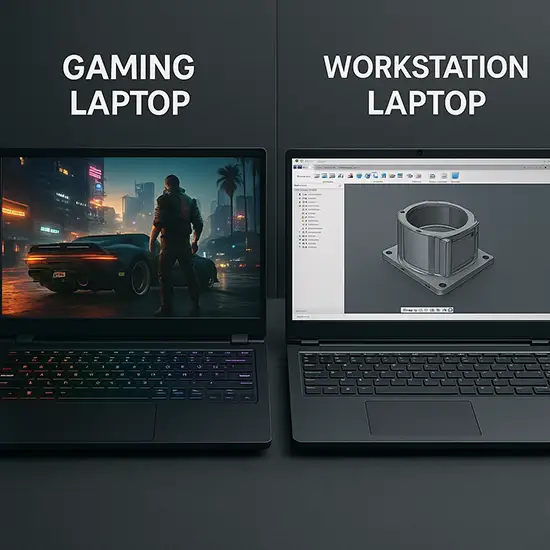
At first glance, a gaming laptop and a workstation laptop can look very similar. Both might have fast processors, powerful graphics cards, and even large displays. But under the hood, they’re built with different priorities in mind — and choosing the wrong one can leave you either overspending or underperforming for your needs.
What is a Gaming Laptop?
A gaming laptop is optimized for real-time performance, especially in graphics-intensive applications like video games. These laptops are designed to push high frame rates, reduce input lag, and handle quick GPU rendering. Key features include:
- High refresh rate displays (120Hz to 240Hz)
- Dedicated gaming GPUs (NVIDIA GeForce RTX series)
- Optimized for DirectX, Vulkan, and real-time graphics
- Emphasis on thermal design for sustained performance
- Usually more RGB, louder fans, and gamer-focused aesthetics
They’re ideal not just for gaming, but also for users who need GPU power at a lower cost — such as streamers, 3D learners, and even some content creators.
What is a Workstation Laptop?
A workstation laptop, on the other hand, is tailored for professional software, stability, and precision. These machines are built for engineers, designers, and developers who rely on certified hardware to run complex applications. You’ll often find:
- Professional-grade GPUs (NVIDIA Quadro / RTX A-series)
- ECC memory (error-correcting RAM)
- Certification for CAD, CAM, 3D modeling software (AutoCAD, SolidWorks, Revit)
- Focus on color-accurate displays and extended memory capacity
- Usually quieter, with more subtle design
They are also built to run under load for long periods, which is crucial for rendering, simulations, or machine learning tasks.
Which One Should You Choose?
If your primary use involves gaming — even alongside streaming or light video editing — a gaming laptop offers better value. You get more GPU performance per dirham, and many gaming laptops can still handle creative tasks.
But if you’re a professional working with certified software or you need absolute display accuracy and reliability, a workstation laptop is likely a better fit.
Example Use Cases
| Use Case | Better Choice |
|---|---|
| Playing AAA games + Twitch stream | Gaming Laptop |
| 3D rendering with SolidWorks | Workstation Laptop |
| Studying + casual gaming | Gaming Laptop |
| Architectural visualization | Workstation Laptop |
| Video editing for YouTube | Gaming Laptop |
| Deep learning / simulations | Workstation Laptop |
Can You Use a Gaming Laptop for Work?
Yes — in fact, many users buy a gaming laptop to handle both entertainment and productivity. Laptops with RTX 4050 or 4060 are more than capable of running Adobe software, Blender, and even light CAD work. Just be aware that they may lack professional certifications or ultra-precise color displays found in workstation models.
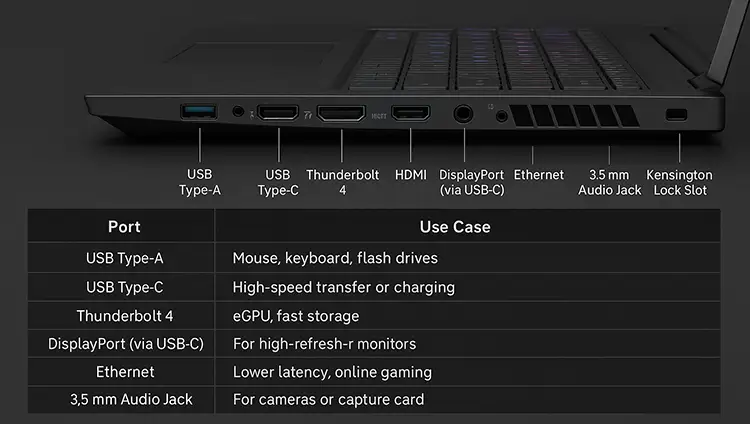
Connectivity Ports Breakdown – What to Look For in a Gaming Laptop
When choosing a gaming laptop, it's easy to focus on internal specs like GPU and CPU — but external connectivity can have a real impact on your experience too. Whether you're plugging into an external monitor, using a wired mouse, or transferring files from a camera, the right set of ports makes a difference.
Here’s a breakdown of the most common ports you’ll find on a modern gaming laptop, and what each one is typically used for:
| Port | Use Case |
|---|---|
| USB Type-A | Standard USB port for mouse, keyboard, flash drives, or external SSDs. |
| USB Type-C | High-speed data transfer, charging, or connecting to modern displays. |
| Thunderbolt 4 | Supports fast storage, external GPUs (eGPU), and dual 4K displays. |
| HDMI 2.1 | Connect to external monitors or TVs; supports 4K at 60Hz or 144Hz. |
| DisplayPort (via USB-C) | Alternative to HDMI; often used for high-refresh rate monitors. |
| Ethernet (RJ-45) | Essential for stable, low-latency online gaming over a wired connection. |
| 3.5mm Audio Jack | For headsets, gaming headphones, or external speakers. |
| SD Card Reader | Useful for creators and streamers who work with cameras. |
| Kensington Lock Slot | For physically securing your laptop — especially useful in public areas. |
Which Ports Should You Prioritize?
Not every gaming laptop includes every port. Entry-level models may lack Thunderbolt or DisplayPort support, while ultra-slim models might remove Ethernet entirely.
Here’s a quick guide based on how you use your laptop:
- Competitive gamers: Ethernet + multiple USB ports
- Streamers: HDMI + USB-C for webcam, capture card, and mic
- Content creators: USB-C + SD card reader + DisplayPort
- Traveling users: USB-C for charging + compact dongle options
💡 If you plan to game on an external monitor at high refresh rates (144Hz+), check whether your HDMI or USB-C ports support that output — not all of them do.
FAQ
Q: Is RTX 4050 enough for modern games?
Yes — it can handle most 2024–2025 titles at high settings, especially at 1080p. You also get ray tracing and DLSS support.
Q: Should I buy a gaming laptop or build a PC?
If you need portability, go for a laptop. Desktops offer more power per dollar but are less convenient.
Q: How much should I spend?
You can get a decent gaming laptop around 3500–4000 AED, but for long-term value and smoother gameplay, 4500–6000 AED is a solid range.
Q: Are gaming laptops heavy?
Most midrange models weigh around 2.2–2.5kg. Thinner options exist, but may sacrifice thermals.
Q: Is Windows 11 OK for gaming?
Yes. Windows 11 supports DirectStorage and other gaming features. Just make sure your drivers are up to date.
Conclusion: Know What You’re Buying
Buying a gaming laptop is more than just picking a cool-looking machine. You need to think about what kind of games you play, how much you move around, and what level of performance actually matters for you. It’s easy to overspend — or worse, buy something underpowered that won’t last. Hopefully, this guide helped you better understand what to look for.



















